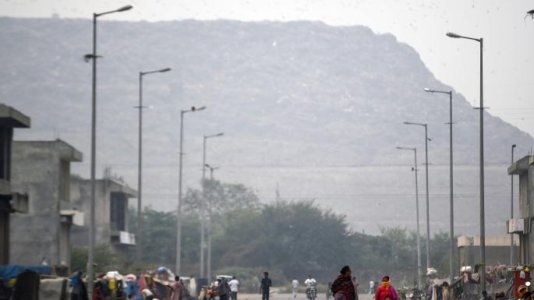Cpt. Rishwat
T20I Captain
- Joined
- May 8, 2010
- Runs
- 44,360
Delhi’s rubbish mountain set to tower higher than the Taj Mahal
One is a towering monument to love. The other is a towering monument to waste.
The mountain of rubbish at the Ghazipur landfill on the outskirts of Delhi is growing so fast that it could be taller than the Taj Mahal within a year, bringing an unwelcome landmark to the Indian capital.
Taking up the area of more than 40 football pitches on the edges of a city which the UN says is the world’s most polluted capital, the Ghazipur dump rises by nearly 10 metres (33 feet) a year. According to east Delhi’s superintendent engineer Arun Kumar, it is already more than 65 metres high.
At its rate of growth, it will be taller than the 73-metre Taj in Agra in 2020. India’s Supreme Court warned last year that red warning lights would soon have to be put on the dump to alert passing jets.
Ghazipur was opened in 1984 and reached its capacity in 2002 when it should have been closed. But the city’s rubbish keeps arriving in hundreds of trucks. Officials say that about 2,000 tonnes of rubbish is dumped at the site every day.
In 2018, a section of the hill collapsed in heavy rains killing two people. Dumping was banned after the deaths, but the measure lasted only a few days because authorities could not find an alternative. Fires, sparked by methane gas coming from the dump, regularly break out and take days to extinguish.
Shambhavi Shukla, senior researcher at the Centre for Science and Environment in Delhi, told the AFP news agency that methane belching from the garbage could become even more deadly when mixed with the atmosphere. Meanwhile, a black toxic liquid oozes from the dump into a local canal. “It all needs to be stopped as the continuous dumping has severely polluted the air and ground water,” said Chitra Mukherjee, head of Chintan, an environment advocacy group.
Residents say the dump often makes breathing virtually impossible. “The poisonous smell has made our lives hell. People fall sick all the time,” said Puneet Sharma, a 45-year-old local resident.
Indian cities are among the world’s largest rubbish producers, generating 62 million tonnes of waste annually. By 2030, that could rise to 165 million tonnes, according to government figures.
https://www.thetimes.co.uk/edition/...-to-tower-higher-than-the-taj-mahal-8b0sdnw03
Look at that heap in the background. It really does look like a mountain. Delhi used to be the capital city in India, quite shocking the state of it these days.







 They'll boast how another record has been broken by them.
They'll boast how another record has been broken by them.

